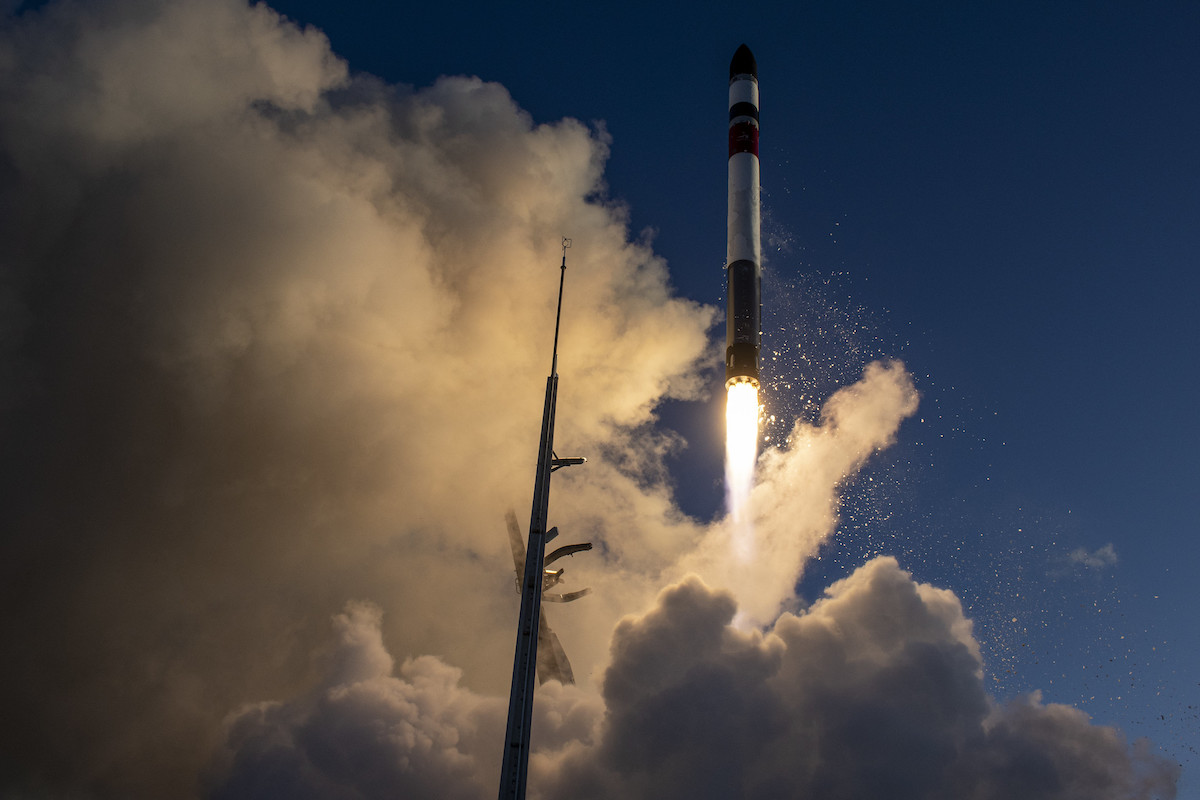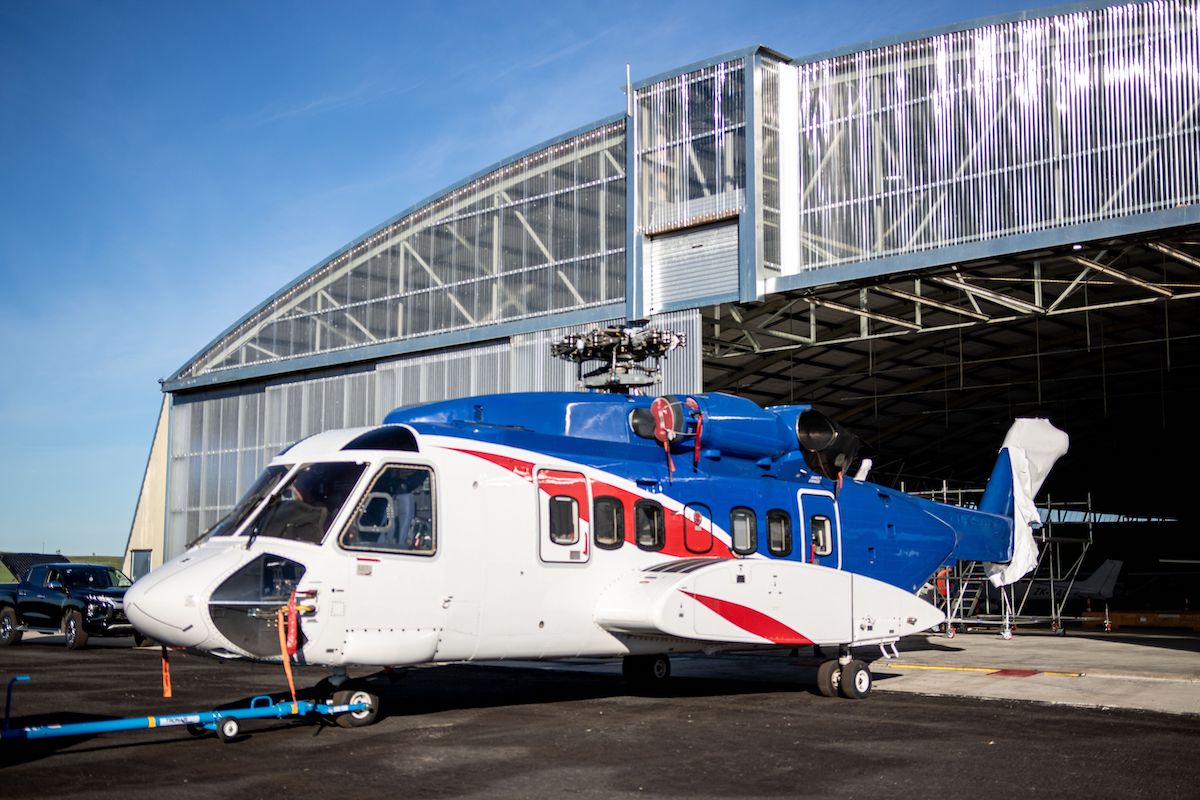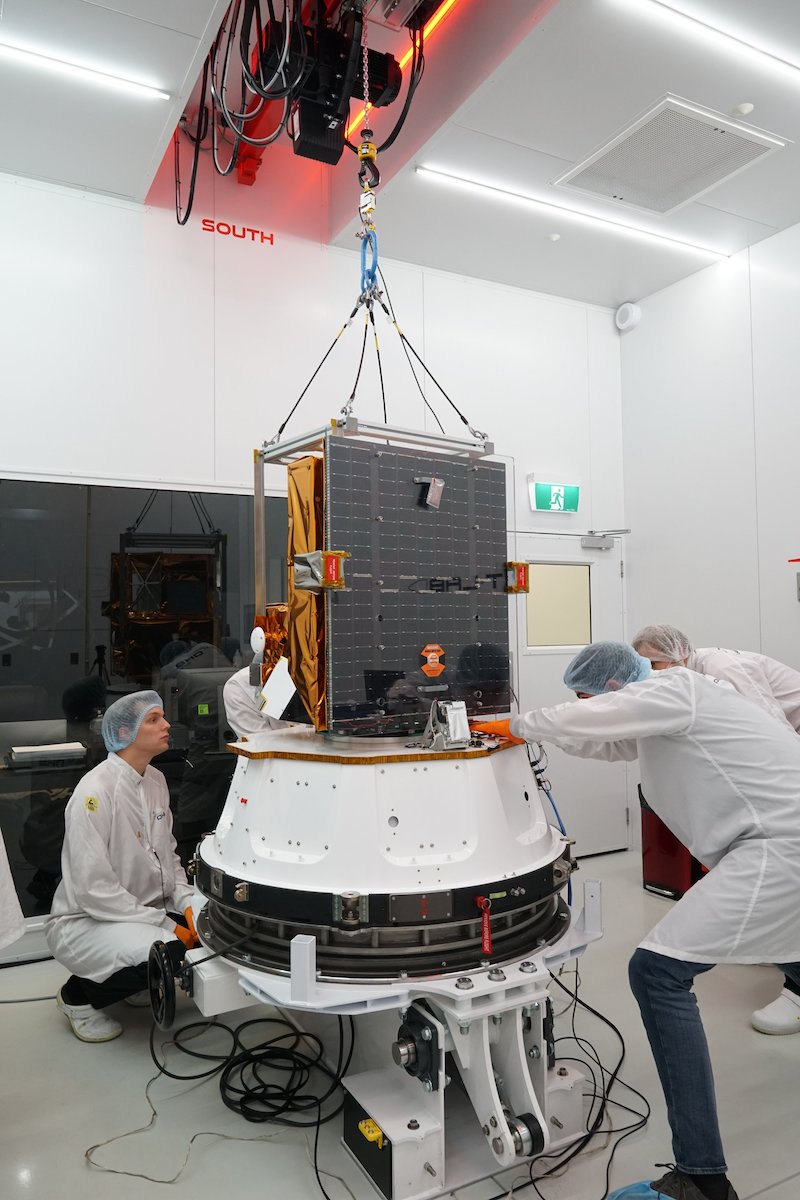
Rocket Lab’s Electron launcher placed a small Swedish atmospheric research satellite into an on-target polar orbit Friday, but an attempt to recover a booster stage with a helicopter was aborted after a brief telemetry loss from the rocket on descent.
The nearly 60-foot-tall (18-meter) Electron rocket took off from Rocket Lab’s privately-owned spaceport in New Zealand at 1:27:14 p.m. EDT (1727:14 GMT) Friday. Nine Rutherford main engines powered the launcher off the pad on Mahia Peninsula, located on the North Island of New Zealand, with more than 50,000 pounds of thrust as the Electron rocket headed south over the Pacific Ocean.
Liftoff occurred at 6:27 a.m. local time Saturday in New Zealand.
The first stage shut off its engines about two-and-a-half minutes into the flight, then separated from Rocket Lab’s second stage, which ignited a single engine to accelerate Sweden’s MATS atmospheric science spacecraft into orbit. A final stage, or kick stage, maneuvered into a more circular orbit at an altitude of about 363 miles (585 kilometers) before deploying the 119-pound (54-kilogram) MATS satellite.
The first stage booster, outfitted with a protective heat shield, continued arcing downrange and plunged back into the atmosphere.
The booster was expected to reach a a top speed of 5,150 mph (8,300 kilometers per hour). Aerodynamic drag slowed the rocket’s velocity as external temperatures built up to 4,350 degrees Fahrenheit (2,400 degrees Celsius).
But ground controllers lost contact with the 39-foot-long (11.9-meter) booster stage during descent. As a safety precaution, the Sikorsky S-92 recovery helicopter flying over the Pacific Ocean to catch the booster moved out of the capture zone, “per standard safety procedure,” Rocket Lab said.
The booster splashed down under a parachute, and a recovery ship moved alongside the rocket to pull it from the sea and return it to Rocket Lab’s development and manufacturing facility in Auckland, the company said in a post-launch statement.
Liftoff of Rocket Lab’s Electron launcher, boosting a Swedish atmospheric research satellite into orbit while making new strides in rocket reusability. https://t.co/tpI8vI8oxi pic.twitter.com/AUcwUAV182
— Spaceflight Now (@SpaceflightNow) November 4, 2022
Rocket Lab wants to recover and reuse the Electron rocket’s first stage, which does not have enough reserve fuel to perform a propulsive landing like SpaceX’s Falcon 9 rocket. So Rocket Lab devised a recovery method using a parachute and a helicopter to capture the Electron first stage in mid-air.
Engineers completed several experiments to test the Electron booster’s heat shield and parachute system. On those missions, Rocket Lab retrieved the booster from the Pacific Ocean downrange from the launch site in New Zealand.
Rocket Lab added the recovery helicopter to the mix on a May 2 launch. A customized Sikorsky S-92 helicopter fitted with a long boom snared the booster as it descended under parachute, but the helicopter pilot commanded release of the rocket after sensing “different load characteristics” than experienced during previous tests, Rocket Lab said.
After additional training and rehearsals, Rocket Lab was ready to try again with the helicopter. But this time, safety concerns associated with the loss of telemetry from the booster prompted the helicopter to fly clear of the recovery area as a precaution.
“Rocket telemetry dropped out (it happens a bit during re-entry) but we did not regain a solid link in time,” tweeted Peter Beck, Rocket Lab’s founder and CEO. “Without that link, it’s just not safe to put the helicopter into the recovery zone, so we stood it off. The great thing about recovery is you get it back to see what happened.”
The Sikorsky S-92 helicopter attempted to capture the rocket by its parachute about 180 miles (290 kilometers) off the coast of New Zealand. Rocket Lab nicknamed the mission “Catch Me If You Can.”
Catching the booster in mid-air prevents it from reaching the ocean, eliminating the risk of hardware corrosion or damage from splashdown in salt water, and easing refurbishment work required to make the rocket suitable to launch again.

Despite the problem securing the booster with the helicopter during the May 2 mission, Rocket Lab recovered the rocket from the sea brought it back to shore, similar to the plan for the booster after Friday’s launch.
The company announced Sept. 1 that it completed a full-duration, full-thrust test-firing of a refurbished engine from the booster recovered in May. The engine passed all of the “rigorous acceptance tests” Rocket Lab performs for every engine, including 200 seconds of burn time and multiple restarts, the company said.
The refurbished engine “performed to the same standard of a newly-built Rutherford engine,” Rocket Lab said. The company doesn’t plan to fly the engine again, but will it will be a “life-leader” to support future Rutherford engine development.
A successful mid-air recovery would be a big step forward for Rocket Lab’s aim to refurbish and reuse an entire Electron booster stage.
“Bringing a rocket back from space is a challenging task and capturing it mid-air with a helicopter is as complex as it sounds,” Beck said. “The chances for success are much smaller than that of failure because many complex factors that must perfectly align. We are proud to have successfully recovered our fifth rocket from the ocean now and we look forward to another mid-air capture attempt in future as we work toward making Electron a reusable rocket.”
The mission Friday hauled Sweden’s Mesospheric Airglow/Aerosol Tomography and Spectroscopy, or MATS, satellite into polar orbit. The MATS mission is funded by the Swedish National Space Agency, and is designed to study waves in Earth’s atmosphere.
The satellite was built by OHB Sweden, and carries an instrument to image variation in light emitted by oxygen molecules in the upper atmosphere, as well as noctilucent clouds that form about 50 miles (80 kilometers) above Earth’s surface. OHB Sweden said in a post-launch press release that ground controllers established communications with the MATS satellite, confirming it to be in good health following deployment in orbit.

Observations of the structure of noctilucent clouds can provide information about wave movements in the upper atmosphere. Scientists want to know how the atmospheric waves are linked to Earth’s climate.
“MATS will provide researchers with unique data and make it possible for researchers around the world to increase their knowledge of the climate system, at the same time that the climate issue affects more and more people, not least through extreme weather,” said Anna Rathsman, director general of the Swedish National Space Agency, in a statement.
MATS is the first Swedish science satellite to launch in more than 20 years. The MATS spacecraft is designed for a mission lasting at least two years.
“We hope that MATS will give us a better understanding of how angular momentum and energy are transported between different parts of the atmosphere. This is an area with large knowledge gaps that MATS will help us fill,” said Linda Megner, a researcher at Stockholm University’s department of meteorology.
The MATS satellite was originally assigned to launch as a rideshare payload on a Russian Soyuz rocket, but Swedish officials moved the mission to a dedicated launch on a Rocket Lab mission after Russia’s invasion of Ukraine earlier this year.
In a press release, Rocket Lab said it accommodate the MATS launch on its schedule in just four months from contract signing.
Email the author.
Follow Stephen Clark on Twitter: @StephenClark1.
